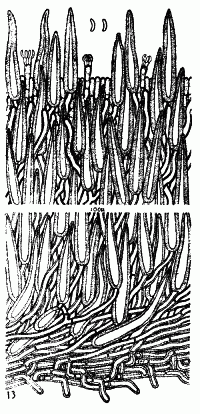|
 Hymenochaete plurimaesetae Hymenochaete plurimaesetae
SynonymsHymenochaete floridea
BiostatusPresent in region - Indigenous. Endemic
Images (click to enlarge)
Caption: Pl. 3, fig. 2. Hymenochaete plurimaesetae G.H.Cunn. x 1. Orbicular colonies with free plane
margins. | 
Caption: FIG. 13. Hymenochaete plurimaesetae G.H.Cunn. Transverse section x 500; spores x 1000. |
Article: Cunningham, G.H. (1963). The Thelephoraceae of Australia and New Zealand. New Zealand Department of Scientific and Industrial Research, Bulletin 145: 359 p. Wellington:.
Description: Hymenophore resupinate, annual, membranous, adherent, at first
appearing as small orbicular scattered colonies 0.5-2 cm across, merging to form
irregular linear areas 5-15 x 2-6 cm; hymenial surface reddish-brown, often with
a purple tinge or purplish when old, even or irregularly roughened, finely
velutinate, either without crevices, tardily creviced, or in old specimens
sometimes exhibiting radiate series of crevices as in H. obesa; margin
thinning out, fibrillose, loosely attached, narrow or broad, fulvous. Context
ferruginous, 150-250 µm thick, of mainly parallel hyphae rather loosely
arranged, cortex of cemented intertwined hyphae bearing abhymenial hairs of
irregular length; skeletal hyphae 4-5 µm diameter, walls 0.5-1 µm thick, golden
yellow; generative hyphae 2-2.5 µm diameter, walls 0.25 µm thick, hyaline. Setal
layer 80-130 µm deep, of 2-5 crowded overlapping rows of setae embedded among
erect skeletal hyphae and of one or two rows of larger, scattered and often
distorted setae in the context; setae irregularly fusiform, a few subulate, some
projecting to 40 µm, 40-70 x 6-10 µm (some in the context to 85 µm long), walls
delicately verruculose at apices, rich chestnut with moderately narrow lumena.
Hymenial layer to 25 µm deep, a close palisade of basidia and paraphyses.
Basidia subclavate, 12-15 x 3-4 µm, bearing 2-4 spores; sterigmata
slender, slightly arcuate, to 5 µm long. Paraphyses cylindrical, 8-12 x 3-4 µm.
Spores allantoid, 4-5 x 1 µm, walls smooth, hyaline, 0.1 µm thick.
Habitat: HABITAT: Bark of dead branches and trunks associated with a white rot.
Distribution: DISTRIBUTION: Ceylon, Australia, New Zealand.
Notes: Collections agree in microfeatures with the type in Kew herbarium, ex
"Central Provinces, Thwaites, No. 336". Many differ in being less brightly
coloured, a feature without taxonomic significance. The species may be separated
from others of this section by the small allantoid spores; small setae crowded
into several overlapping rows, reddish-brown colour of the hymenial surface and
fulvous margin. It is liable to confusion with H. plurimaesetae,
differing in features discussed under the latter. Sometimes the cortex is
suppressed where tissues are in contact with the substratum; but sections from
the free peripheral region demonstrate its presence. Most collections were taken
from upright dead trunks and saplings, when the upper margins become thickened
to simulate rudimentary pilei.
Article: Cunningham, G.H. (1957). Thelephoraceae of New Zealand. XIV. The genus Hymenochaete. Transactions of the Royal Society of New Zealand 85(1): 1-51.
Description: Hymenophore resupinate, annual, coriaceous-brittle, closely adnate, forming irregularly
orbicular colonies 2-20 mm across. Hymenial surface ferruginous or cinnamon, tuberculate,
deeply irregularly creviced, especially towards the centre; margin concolorous, thinning out,
definite, lobed. Context ferruginous, 150-250 µ thick, composed of an intermediate tissue of
loosely arranged parallel hyphae and a cortex 10-15 µ thick bearing a few brief abhymenial
hairs; hyphal system dimitic; skeletal hyphae varying in thickness, 2-4-6 µ diameter, walls
0.5-1.5 µ thick, golden yellow, branched, septate; generative hyphae 2.5-3 µ diameter, walls
0.25 µ thick, hyaline, branched, septate. Setal layer occupying the greater part of the context,
150-200 µ deep, of 10-15 overlapping rows of setae embedded in branched brown hyphae;
setae projecting to 40 µ, commonly subulate, or irregularly fusiform, 40-65 x 7-9 µ, many
buried in the context when laying at all angles, often distorted, walls irregularly and often
coarsely verruculose, reddish-brown, lumina broad. Hymenial layer to 40 µ deep, a dense
palisade of basidia and paraphyses. Basidia subclavate, 12-16 x 3.5-4 µ, 2-4-spored;
sterigmata slender, slightly arcuate, to 5 µ long. Spores allantoid, 4-5 x 1-1.5 µ, walls smooth,
hyaline 0.1 µ thick.
Habitat: HABITAT: Scattered or crowded on bark and decorticated wood of branches and stems,
associated with a white rot.
Distribution: DISTRIBUTION: New Zealand.
Notes: Separated from H. floridea, which it resembles in microfeatures, by the ferruginous or
cinnamon colour of the hymenial surface, absence of a differently coloured margin, and
brittle context. In minor microfeatures they also differ; for in H. plurimaesetae the setal layer
is so thickened as to occupy the greater part of the context, so that the intermediate tissue is
reduced to a somewhat tenuous layer. The cortex may be well developed, scanty or, where the
section contacts the substratum, suppressed. It is always present in some portion of the plant,
however, as may be demonstrated by sections prepared from different parts. In some
collections two or three darker bands traverse the setal layer; they are absent from others so
are without taxonomic import.
|